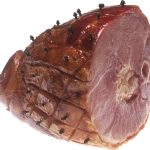 Back in the sixteenth century, when fawning courtiers complimented Queen Elizabeth for her hams, they were not praising her culinary skills, but rather her limber legs that allowed her to dance more featly and jump more lightly than any other woman in her court. One Renaissance painter even depicted the dancing Queen in the midst of a marvellous leap, her feet higher than the shoulders of the admiring courtiers, who must crane back their heads to view her manifest grace and magnificent hams. Ham, in fact, was commonly used to refer to the human leg up until the nineteenth century, a usage still evident in hamstring, the name of the tendon running behind your knees. It was not until the mid seventeenth century that ham also acquired the more specific sense of a particular cut of pork, one taken from the rear leg of a pig. In origin, the word ham, .which appeared in English about a thousand years ago, derives from a Germanic source that meant crooked or bent, a leg’s ability to bend being one of the things that makes walking possible (the word elbow likewise derives from two Germanic words meaning arm-bend). The ham that means bad actor may or may not derive from the culinary ham: it may have come from ham fat (a substance once used to remove theatrical makeup), or from amateur (pronounced by over-aspirating thespians as hamateur), or from Hamlet (a role prone to over acting). The name Hamlet, incidentally, derives from a source meaning little home, not little ham.
Back in the sixteenth century, when fawning courtiers complimented Queen Elizabeth for her hams, they were not praising her culinary skills, but rather her limber legs that allowed her to dance more featly and jump more lightly than any other woman in her court. One Renaissance painter even depicted the dancing Queen in the midst of a marvellous leap, her feet higher than the shoulders of the admiring courtiers, who must crane back their heads to view her manifest grace and magnificent hams. Ham, in fact, was commonly used to refer to the human leg up until the nineteenth century, a usage still evident in hamstring, the name of the tendon running behind your knees. It was not until the mid seventeenth century that ham also acquired the more specific sense of a particular cut of pork, one taken from the rear leg of a pig. In origin, the word ham, .which appeared in English about a thousand years ago, derives from a Germanic source that meant crooked or bent, a leg’s ability to bend being one of the things that makes walking possible (the word elbow likewise derives from two Germanic words meaning arm-bend). The ham that means bad actor may or may not derive from the culinary ham: it may have come from ham fat (a substance once used to remove theatrical makeup), or from amateur (pronounced by over-aspirating thespians as hamateur), or from Hamlet (a role prone to over acting). The name Hamlet, incidentally, derives from a source meaning little home, not little ham.
A cut of pork, the hind leg specifically, that has been specially prepared and cured in a mixture of salt and saltpeter is commonly known as a ham. The shoulder of the hog can also be prepared in the same way and referred to as ham. Hams are often smoked or aged to enhance their flavor and can be served as a main course, sliced for sandwiches, or used as a flavoring agent in soups and stews.
The region stretching from the buttock to the back of the knee that contains the hamstring muscles.
